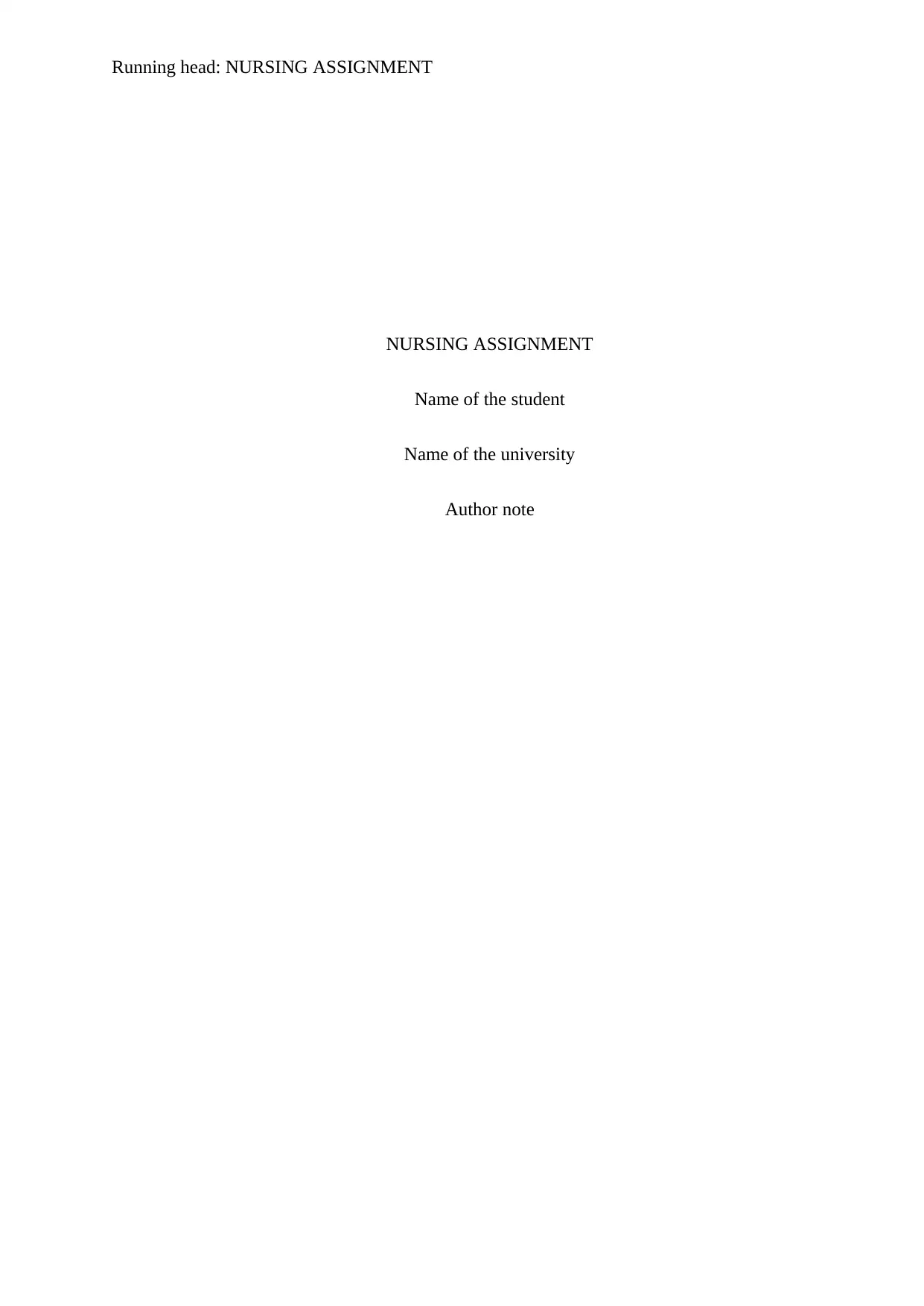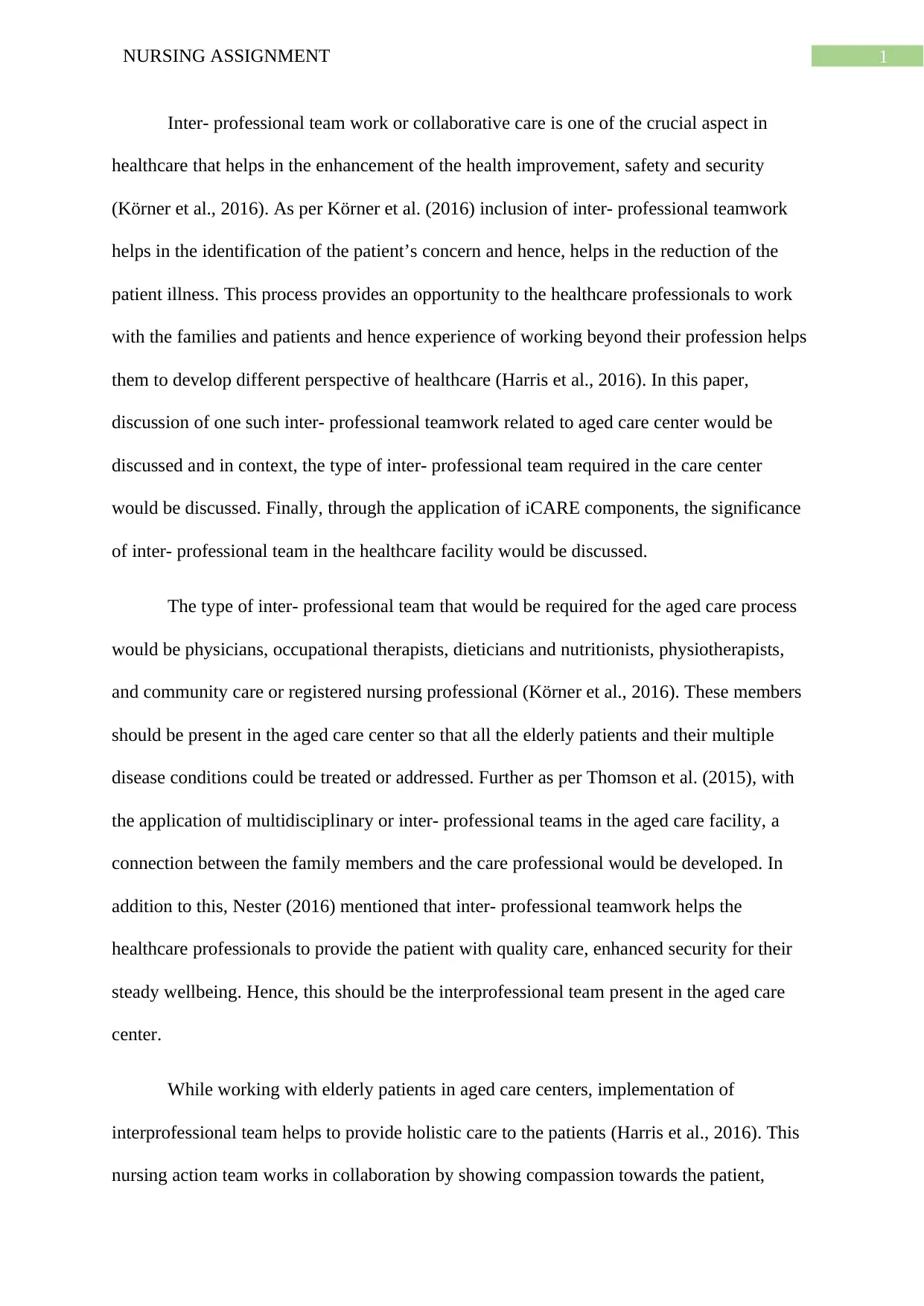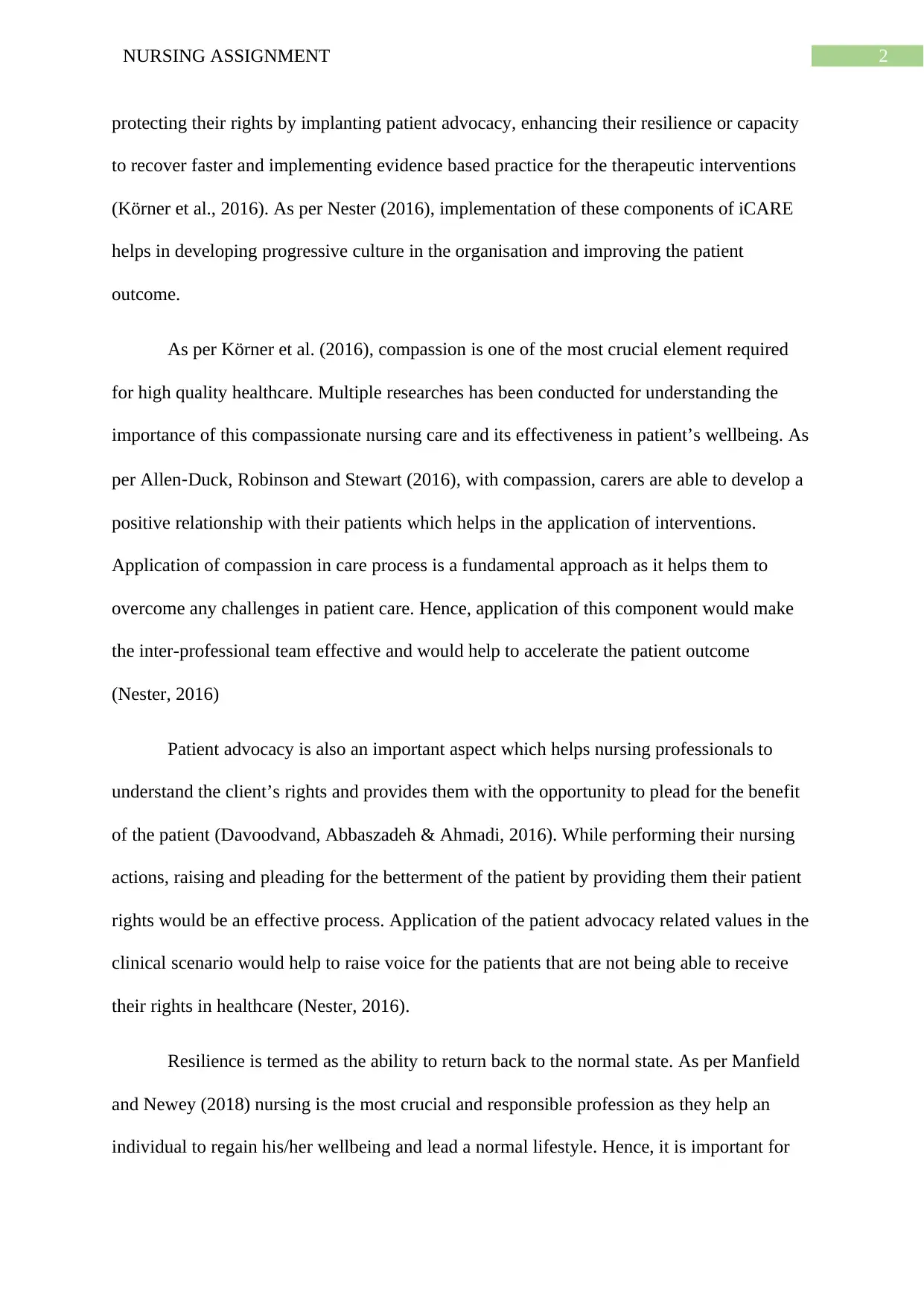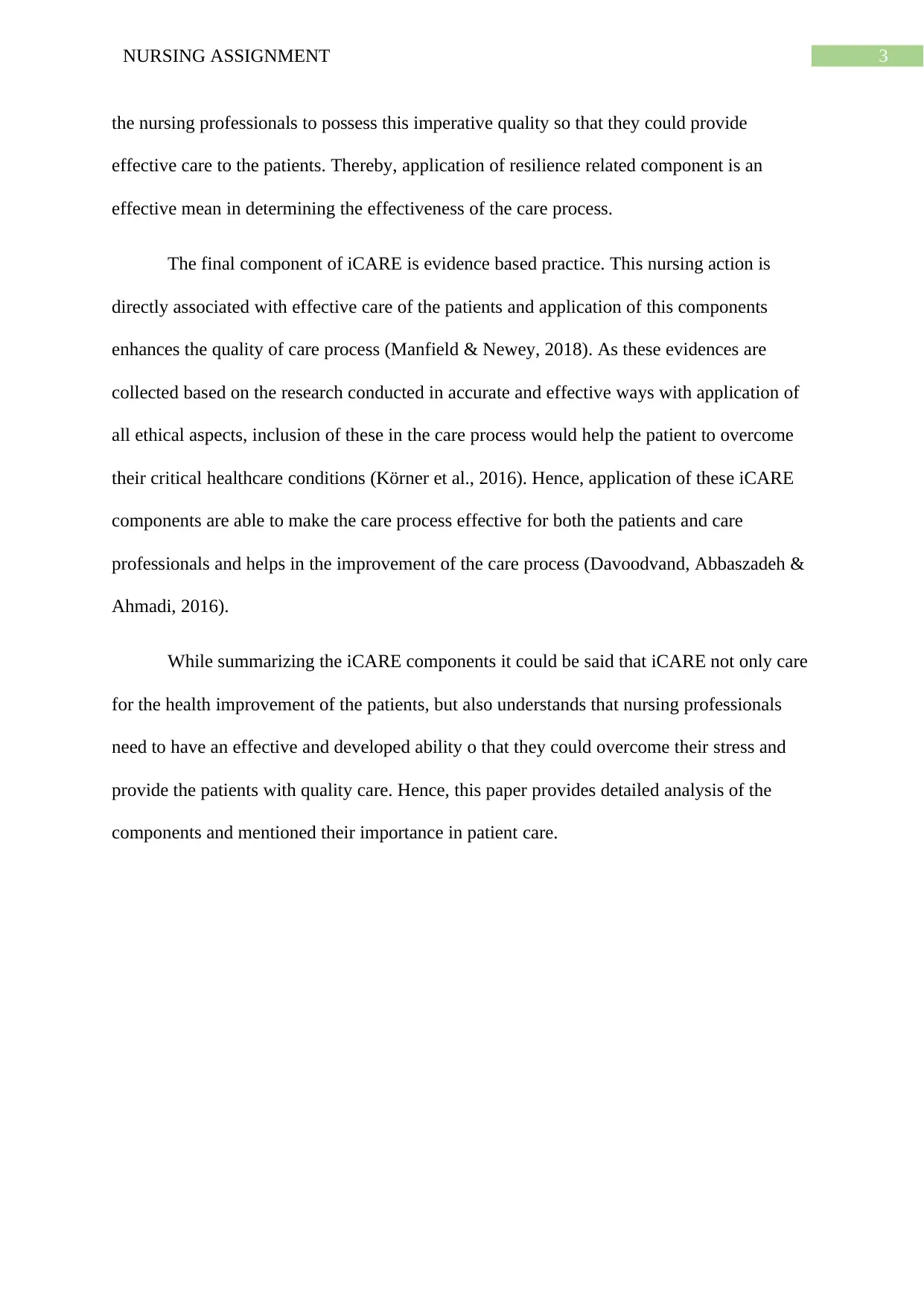NR451 Capstone: iCARE, Interprofessional Teams, and Patient Outcomes
VerifiedAdded on 2022/10/12
|6
|1291
|390
Report
AI Summary
This report examines the significance of interprofessional teamwork in healthcare, specifically within an aged care setting. It identifies the essential members of an interprofessional team, including physicians, therapists, dieticians, and nurses, highlighting their roles in providing comprehensive care for elderly patients. The paper applies the iCARE components—compassion, advocacy, resilience, and evidence-based practice—to illustrate how nursing actions within these teams can enhance patient outcomes and foster a positive organizational culture. The discussion emphasizes the importance of compassion in building patient relationships, advocacy in protecting patient rights, resilience in promoting patient recovery, and evidence-based practice in delivering quality care. The paper concludes by summarizing the benefits of the iCARE framework, recognizing the importance of supporting nurses to deliver quality care and overcome stress. This assignment provides a detailed analysis of the iCARE components and their impact on patient care.

Running head: NURSING ASSIGNMENT
NURSING ASSIGNMENT
Name of the student
Name of the university
Author note
NURSING ASSIGNMENT
Name of the student
Name of the university
Author note
Paraphrase This Document
Need a fresh take? Get an instant paraphrase of this document with our AI Paraphraser

1NURSING ASSIGNMENT
Inter- professional team work or collaborative care is one of the crucial aspect in
healthcare that helps in the enhancement of the health improvement, safety and security
(Körner et al., 2016). As per Körner et al. (2016) inclusion of inter- professional teamwork
helps in the identification of the patient’s concern and hence, helps in the reduction of the
patient illness. This process provides an opportunity to the healthcare professionals to work
with the families and patients and hence experience of working beyond their profession helps
them to develop different perspective of healthcare (Harris et al., 2016). In this paper,
discussion of one such inter- professional teamwork related to aged care center would be
discussed and in context, the type of inter- professional team required in the care center
would be discussed. Finally, through the application of iCARE components, the significance
of inter- professional team in the healthcare facility would be discussed.
The type of inter- professional team that would be required for the aged care process
would be physicians, occupational therapists, dieticians and nutritionists, physiotherapists,
and community care or registered nursing professional (Körner et al., 2016). These members
should be present in the aged care center so that all the elderly patients and their multiple
disease conditions could be treated or addressed. Further as per Thomson et al. (2015), with
the application of multidisciplinary or inter- professional teams in the aged care facility, a
connection between the family members and the care professional would be developed. In
addition to this, Nester (2016) mentioned that inter- professional teamwork helps the
healthcare professionals to provide the patient with quality care, enhanced security for their
steady wellbeing. Hence, this should be the interprofessional team present in the aged care
center.
While working with elderly patients in aged care centers, implementation of
interprofessional team helps to provide holistic care to the patients (Harris et al., 2016). This
nursing action team works in collaboration by showing compassion towards the patient,
Inter- professional team work or collaborative care is one of the crucial aspect in
healthcare that helps in the enhancement of the health improvement, safety and security
(Körner et al., 2016). As per Körner et al. (2016) inclusion of inter- professional teamwork
helps in the identification of the patient’s concern and hence, helps in the reduction of the
patient illness. This process provides an opportunity to the healthcare professionals to work
with the families and patients and hence experience of working beyond their profession helps
them to develop different perspective of healthcare (Harris et al., 2016). In this paper,
discussion of one such inter- professional teamwork related to aged care center would be
discussed and in context, the type of inter- professional team required in the care center
would be discussed. Finally, through the application of iCARE components, the significance
of inter- professional team in the healthcare facility would be discussed.
The type of inter- professional team that would be required for the aged care process
would be physicians, occupational therapists, dieticians and nutritionists, physiotherapists,
and community care or registered nursing professional (Körner et al., 2016). These members
should be present in the aged care center so that all the elderly patients and their multiple
disease conditions could be treated or addressed. Further as per Thomson et al. (2015), with
the application of multidisciplinary or inter- professional teams in the aged care facility, a
connection between the family members and the care professional would be developed. In
addition to this, Nester (2016) mentioned that inter- professional teamwork helps the
healthcare professionals to provide the patient with quality care, enhanced security for their
steady wellbeing. Hence, this should be the interprofessional team present in the aged care
center.
While working with elderly patients in aged care centers, implementation of
interprofessional team helps to provide holistic care to the patients (Harris et al., 2016). This
nursing action team works in collaboration by showing compassion towards the patient,

2NURSING ASSIGNMENT
protecting their rights by implanting patient advocacy, enhancing their resilience or capacity
to recover faster and implementing evidence based practice for the therapeutic interventions
(Körner et al., 2016). As per Nester (2016), implementation of these components of iCARE
helps in developing progressive culture in the organisation and improving the patient
outcome.
As per Körner et al. (2016), compassion is one of the most crucial element required
for high quality healthcare. Multiple researches has been conducted for understanding the
importance of this compassionate nursing care and its effectiveness in patient’s wellbeing. As
per Allen‐Duck, Robinson and Stewart (2016), with compassion, carers are able to develop a
positive relationship with their patients which helps in the application of interventions.
Application of compassion in care process is a fundamental approach as it helps them to
overcome any challenges in patient care. Hence, application of this component would make
the inter-professional team effective and would help to accelerate the patient outcome
(Nester, 2016)
Patient advocacy is also an important aspect which helps nursing professionals to
understand the client’s rights and provides them with the opportunity to plead for the benefit
of the patient (Davoodvand, Abbaszadeh & Ahmadi, 2016). While performing their nursing
actions, raising and pleading for the betterment of the patient by providing them their patient
rights would be an effective process. Application of the patient advocacy related values in the
clinical scenario would help to raise voice for the patients that are not being able to receive
their rights in healthcare (Nester, 2016).
Resilience is termed as the ability to return back to the normal state. As per Manfield
and Newey (2018) nursing is the most crucial and responsible profession as they help an
individual to regain his/her wellbeing and lead a normal lifestyle. Hence, it is important for
protecting their rights by implanting patient advocacy, enhancing their resilience or capacity
to recover faster and implementing evidence based practice for the therapeutic interventions
(Körner et al., 2016). As per Nester (2016), implementation of these components of iCARE
helps in developing progressive culture in the organisation and improving the patient
outcome.
As per Körner et al. (2016), compassion is one of the most crucial element required
for high quality healthcare. Multiple researches has been conducted for understanding the
importance of this compassionate nursing care and its effectiveness in patient’s wellbeing. As
per Allen‐Duck, Robinson and Stewart (2016), with compassion, carers are able to develop a
positive relationship with their patients which helps in the application of interventions.
Application of compassion in care process is a fundamental approach as it helps them to
overcome any challenges in patient care. Hence, application of this component would make
the inter-professional team effective and would help to accelerate the patient outcome
(Nester, 2016)
Patient advocacy is also an important aspect which helps nursing professionals to
understand the client’s rights and provides them with the opportunity to plead for the benefit
of the patient (Davoodvand, Abbaszadeh & Ahmadi, 2016). While performing their nursing
actions, raising and pleading for the betterment of the patient by providing them their patient
rights would be an effective process. Application of the patient advocacy related values in the
clinical scenario would help to raise voice for the patients that are not being able to receive
their rights in healthcare (Nester, 2016).
Resilience is termed as the ability to return back to the normal state. As per Manfield
and Newey (2018) nursing is the most crucial and responsible profession as they help an
individual to regain his/her wellbeing and lead a normal lifestyle. Hence, it is important for
⊘ This is a preview!⊘
Do you want full access?
Subscribe today to unlock all pages.

Trusted by 1+ million students worldwide

3NURSING ASSIGNMENT
the nursing professionals to possess this imperative quality so that they could provide
effective care to the patients. Thereby, application of resilience related component is an
effective mean in determining the effectiveness of the care process.
The final component of iCARE is evidence based practice. This nursing action is
directly associated with effective care of the patients and application of this components
enhances the quality of care process (Manfield & Newey, 2018). As these evidences are
collected based on the research conducted in accurate and effective ways with application of
all ethical aspects, inclusion of these in the care process would help the patient to overcome
their critical healthcare conditions (Körner et al., 2016). Hence, application of these iCARE
components are able to make the care process effective for both the patients and care
professionals and helps in the improvement of the care process (Davoodvand, Abbaszadeh &
Ahmadi, 2016).
While summarizing the iCARE components it could be said that iCARE not only care
for the health improvement of the patients, but also understands that nursing professionals
need to have an effective and developed ability o that they could overcome their stress and
provide the patients with quality care. Hence, this paper provides detailed analysis of the
components and mentioned their importance in patient care.
the nursing professionals to possess this imperative quality so that they could provide
effective care to the patients. Thereby, application of resilience related component is an
effective mean in determining the effectiveness of the care process.
The final component of iCARE is evidence based practice. This nursing action is
directly associated with effective care of the patients and application of this components
enhances the quality of care process (Manfield & Newey, 2018). As these evidences are
collected based on the research conducted in accurate and effective ways with application of
all ethical aspects, inclusion of these in the care process would help the patient to overcome
their critical healthcare conditions (Körner et al., 2016). Hence, application of these iCARE
components are able to make the care process effective for both the patients and care
professionals and helps in the improvement of the care process (Davoodvand, Abbaszadeh &
Ahmadi, 2016).
While summarizing the iCARE components it could be said that iCARE not only care
for the health improvement of the patients, but also understands that nursing professionals
need to have an effective and developed ability o that they could overcome their stress and
provide the patients with quality care. Hence, this paper provides detailed analysis of the
components and mentioned their importance in patient care.
Paraphrase This Document
Need a fresh take? Get an instant paraphrase of this document with our AI Paraphraser

4NURSING ASSIGNMENT
References
Allen‐Duck, A., Robinson, J. C., & Stewart, M. W. (2017, October). Healthcare quality: A
concept analysis. In Nursing forum (Vol. 52, No. 4, pp. 377-386). doi;
https://doi.org/10.1111/nuf.12207
Davoodvand, S., Abbaszadeh, A., & Ahmadi, F. (2016). Patient advocacy from the clinical
nurses' viewpoint: a qualitative study. Journal of medical ethics and history of
medicine, 9. Retrieved from:
https://www.ncbi.nlm.nih.gov/pmc/articles/PMC4958925/
Harris, M. F., Advocat, J., Crabtree, B. F., Levesque, J. F., Miller, W. L., Gunn, J. M., ... &
Russell, G. M. (2016). Interprofessional teamwork innovations for primary health care
practices and practitioners: evidence from a comparison of reform in three
countries. Journal of multidisciplinary healthcare, 9, 35. DOI:
https://dx.doi.org/10.2147%2FJMDH.S97371
Körner, M., Bütof, S., Müller, C., Zimmermann, L., Becker, S., & Bengel, J. (2016).
Interprofessional teamwork and team interventions in chronic care: A systematic
review. Journal of Interprofessional Care, 30(1), 15-28. doi;
https://doi.org/10.3109/13561820.2015.1051616
Manfield, R. C., & Newey, L. R. (2018). Resilience as an entrepreneurial capability:
integrating insights from a cross-disciplinary comparison. International Journal of
Entrepreneurial Behavior & Research, 24(7), 1155-1180. Doi;
https://doi.org/10.1108/IJEBR-11-2016-0368
References
Allen‐Duck, A., Robinson, J. C., & Stewart, M. W. (2017, October). Healthcare quality: A
concept analysis. In Nursing forum (Vol. 52, No. 4, pp. 377-386). doi;
https://doi.org/10.1111/nuf.12207
Davoodvand, S., Abbaszadeh, A., & Ahmadi, F. (2016). Patient advocacy from the clinical
nurses' viewpoint: a qualitative study. Journal of medical ethics and history of
medicine, 9. Retrieved from:
https://www.ncbi.nlm.nih.gov/pmc/articles/PMC4958925/
Harris, M. F., Advocat, J., Crabtree, B. F., Levesque, J. F., Miller, W. L., Gunn, J. M., ... &
Russell, G. M. (2016). Interprofessional teamwork innovations for primary health care
practices and practitioners: evidence from a comparison of reform in three
countries. Journal of multidisciplinary healthcare, 9, 35. DOI:
https://dx.doi.org/10.2147%2FJMDH.S97371
Körner, M., Bütof, S., Müller, C., Zimmermann, L., Becker, S., & Bengel, J. (2016).
Interprofessional teamwork and team interventions in chronic care: A systematic
review. Journal of Interprofessional Care, 30(1), 15-28. doi;
https://doi.org/10.3109/13561820.2015.1051616
Manfield, R. C., & Newey, L. R. (2018). Resilience as an entrepreneurial capability:
integrating insights from a cross-disciplinary comparison. International Journal of
Entrepreneurial Behavior & Research, 24(7), 1155-1180. Doi;
https://doi.org/10.1108/IJEBR-11-2016-0368

5NURSING ASSIGNMENT
Nester, J. (2016). The importance of interprofessional practice and education in the era of
accountable care. North Carolina medical journal, 77(2), 128-132. doi:
10.18043/ncm.77.2.128
Nester, J. (2016). The importance of interprofessional practice and education in the era of
accountable care. North Carolina medical journal, 77(2), 128-132. doi:
10.18043/ncm.77.2.128
⊘ This is a preview!⊘
Do you want full access?
Subscribe today to unlock all pages.

Trusted by 1+ million students worldwide
1 out of 6
Related Documents
Your All-in-One AI-Powered Toolkit for Academic Success.
+13062052269
info@desklib.com
Available 24*7 on WhatsApp / Email
![[object Object]](/_next/static/media/star-bottom.7253800d.svg)
Unlock your academic potential
Copyright © 2020–2025 A2Z Services. All Rights Reserved. Developed and managed by ZUCOL.





